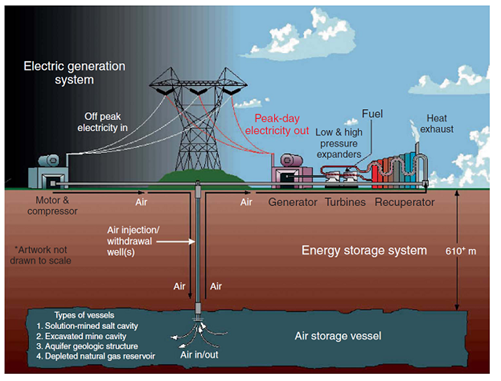Duke Energy is joining a novel $8 billion project using Wyoming wind energy and Utah salt mines to provide power to Los Angeles.
Duke-American Transmission Co. (DATC) is one of four companies proposing the project, which would be the first time underground compressed-air storage would be used on such a scale in the U.S.
“This project would be the 21st century’s Hoover Dam — a landmark of the clean energy revolution,” said Jeff Meyer of Pathfinder Renewable Wind Energy, one of the four companies involved.
Meeting California Renewable Goals
The project is one of about 200 plans California officials will consider to help it reach its renewable-energy goals. Duke and the other companies said they would be submitting the proposal in early 2015.
The project would start with a $4 billion, 2,100-MW wind farm north of Cheyenne, Wyo., to be built by Pathfinder Renewable Wind Energy. Power from the facility would be sent to an energy storage facility near Delta, Utah, on a $2.6 billion, 525-mile transmission line to be built by DATC.
In Utah, four massive caverns — each a quarter-mile high and 290 feet in diameter — would be carved out of underground salt formations.
At times of low demand, electricity from the wind farm would power compressors that would inject high-pressure air into the caverns.
At times of high demand, the high-pressure air, combined with a little natural gas, would power eight generators. The $1.5 billion facility, to be built by Pathfinder, Magnum Energy and Dresser-Rand, would be rated at 1,200 MW.
An existing 490-mile transmission line would deliver the power through Utah, Nevada and California to Los Angeles.
Intermittent Wind

The project is intended to address the challenge of matching wind’s variable output with energy usage patterns.
California’s wind farms tend to generate most of their power in the evening, dropping off when energy demand reaches its peak. Wyoming wind, by comparison, tends to increase later in the day.
Dresser-Rand designed and built the first facility using compressed-air energy storage (CAES) in Alabama; the facility is linked to a coal-fired generating station. The 110-MW unit went into operation in 1991, and boasts a 96.7% reliability record in generation mode. There is one other operating CAES facility in Huntorf, Germany.
If the project goes forward, one of the first jobs will be excavating the caverns, using a process called solution mining. Magnum Energy, which has excavated other storage caverns, said it would inject water into the underground salt formations, dissolving the salt and pumping the salt solution to the surface, where it would be dried. Underground caverns have long been used for oil and natural gas storage.
The project, which is not expected to be completed until 2023, would be subject to numerous state and federal regulatory approvals, none of which has been applied for yet.
See Pathfinder’s video on the project.


